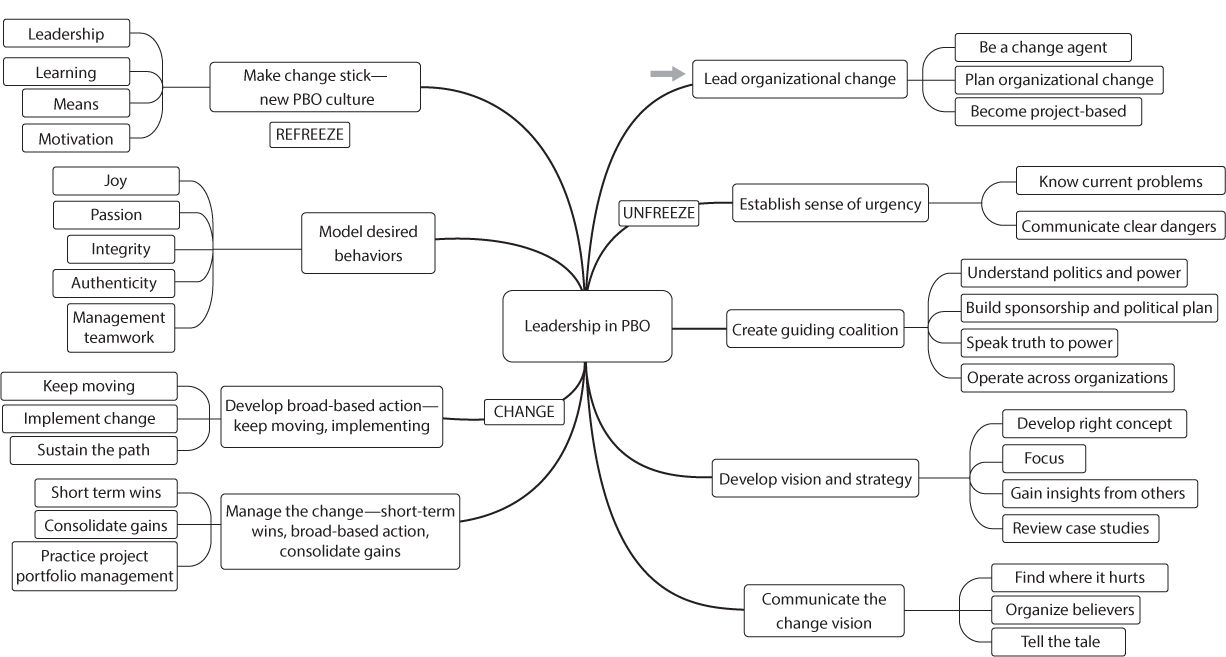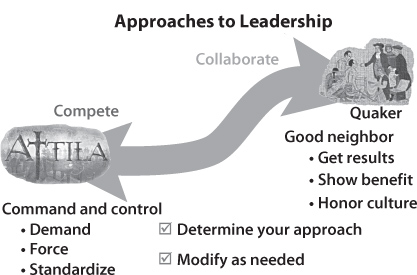EPILOGUE
Leadership in Evolving Project-Based Organizations
Time cannot be stored or stretched and is unidirectional. Time integrates the Universe. Our culture of appreciating time needs a total re-orientation.
ADESH JAIN
As director of the Centre for Excellence in Project Management and editor of the Indian Project Management Journal, Adesh Jain points out that today the rate of change is unprecedented, resulting in the need to manage complex and nonlinear transition processes. Project management is emerging as a key profession to deal with change effectively. We need leaders who can step up to this challenge (Englund and Jain, 2003).
Project management is the art and science of converting vision into reality and abstract into concrete. Christopher Columbus’s vision was to discover the undiscovered; his reality was the “discovery” of America. The new frontier of project management includes a vision to make citizens and corporations happier and more productive; the reality involves applying and improving scientific project management processes. These steps require leadership in a changing and fast-moving environment. Through project management, an organization addresses the issues of change and transition throughout a life cycle.
All projects involve change; thus, every project manager and all team members become involved in an organizational change process. We want to address modern change agents—those who in their quest for knowledge about specific actions can create and sustain a project-based organization. Because a project-based-organization approach is vital to most organizations, every reader, in almost every endeavor, can benefit by following the process we describe. The objective is to share concepts and practices that help project participants at all levels of an organization make sense of the change processes they need to lead.
People may come to a leadership role accidentally, by default, by choice, or by ambitious intent, but sooner or later, all professionals find a leadership role thrust on them—a team to lead or a project to accomplish with others. To be successful in this environment requires people and organizational skills. Greater success comes to those who define, develop, and refine a plan to be successful. These people ultimately embrace the journey or process of changing an organization to be more efficient and more profitable by developing an organization-wide project management system, often called enterprise project management. Wise are the persons who choose a proactive path, employing a change management process, rather than wishing retrospectively that they had done so.
The path includes many uncertainties. Leadership is a key to managing uncertainties. And modern project management provides effective strategies to reduce uncertainties throughout project life cycles.
Leadership has different dimensions than management does. Few people get anointed with the title of and authority as manager. We speak here not of a “great man” approach to leadership but rather of an every person situational role. Each person on a project team inevitably has an opportunity at some time to express leadership. Opportunity comes to those who are ready for it—in this case, those who understand and can apply a change management process.
Change is not an isolated phenomenon. It engulfs every living being within organizations. Often, we close our minds to new things and look for precedents as if tomorrow is an extension of today. The compression of time and the unprecedented challenges we face mean that only those companies that have project management processes in place and are proactive in managing change will survive. If companies and people adopt a reactive mode in facing change, they cannot survive, let alone thrive.
An imperative is to support enterprise-wide change. The boundaries of a modern enterprise need to include customers and contractors. Support does not just happen— it must be elicited. Effective leadership includes the art of eliciting support. Figure E.1 illustrates a process (path) to get support and achieve results. Start from the upper right corner and move clockwise.
The enterprise approach to managing projects is a managerial philosophy based on the principle that company goals are achievable through a web of simultaneous projects. In today’s race against time, there can be little meaning to managing single projects in isolation or operating in functional silos. This calls for a systemic approach. The concept is based on the idea that prosperity depends on adding value to business and that value is added by systematically implementing projects of all types across the enterprise. If projects are managed more effectively, the company’s bottom line is greatly enhanced.
Source: Adapted from Englund, Graham, and Dinsmore (2003).
The aim we espouse is to develop a group of change agents whose efforts are enthusiastically applied throughout the organization in a way that brings about real change. Ultimately, organizations have to balance the ratio of the investment in new projects with ongoing operational investments. The higher the ratio, the more importance must be placed on visions of futuristic aspects for making organizations sustainable.
Lead Organizational Change. Begin the journey by determining what needs to be done to lead real change in the organization. View the organization change process from a different slate. Be careful not to get bogged down by current constraints. Look at new processes without bias. Often, the existing boundaries create roadblocks in viewing new things objectively and developing new commitments. Appreciate the positive qualities and examples that exist and led to current levels of achievement. Instead of a reorganization (which is often incorrectly the first rather than one of the last things done), what is needed is to re-create an organization to build on its existing strengths.
Start any change process by assembling a group of people who share a common core and believe that change is possible and desirable. Demonstrate how the change is good for the organization, and then work to have this change adopted throughout the organization. A PMI PM Network article, “Implementing a Project Office for Organizational Change,” described this “Quaker” approach to organizational change (Englund and Graham, 2001). Early Quakers set up farms near Native American territories and went about their business of growing crops, producing bountiful harvests. Hungry Natives came to ask, “How do you produce such bounty?” Educating indigenous peoples to new agricultural ways was much easier once the benefits were clear.
The successful movement to develop a project-based organization will eventually lead to radical change in organization practices. As with any other radical change process, those in the vanguard will often feel like missionaries introducing new practices into a hostile environment. It is essential that the approach be aligned with organizational culture. Much of this will be missionary work: trying to convince people they will be better off if they change to new ways. The metaphor of the Quaker approach to organizational change is a valuable reference point to consider. It is one end of a continuum about how to implement a project office.
As Figure E.2 illustrates, the other end of the continuum is the old hierarchy, command and control, “Attila,” do-what-I-say approach. As a leader, Attila the Hun was able to get people to do what he commanded, mainly through his aggressive, ambitious, and arrogant nature. He was a savage conqueror who compelled those not destroyed by combat to serve in his armies. He caused vast sufering and died, possibly by those he commanded, before his invasion plans could be carried out.
Change agents and their sponsors can assess where they are on the continuum based on the current organizational culture. Design a plan resonant with that position, and possibly aim to shift direction over time. A hybrid strategy may be very effective: start with a grassroots small success that is comfortable for everyone concerned, and then enlist upper management support to mandate its use across the organization.
Establish a Sense of Urgency—a Clear Danger. A first step in creating the conditions for change in any organization is to establish a sense of urgency for the change. Learning new processes and doing things differently can become difficult transition problems for many members of the organization. People only willingly do those things they value.
A management myth exists that people naturally resist change. That is not quite accurate: people tend to resist change that they feel is not in their best interest, but they embrace changes that they believe are in their best interest and that they are in a position to shape. Establishing a clear sense of urgency and identifying consequences of nonaction make it clear that this change is in their best interest. The merit of a change must be fairly well established in the financial plan and be governed by market conditions. Be clear about the problem that needs solving or the consequences of maintaining the status quo. Focus on significant long-term issues, not just a current fad or temporary fire.
Create a Guiding Coalition. Develop a group of people across the organization who will help define the changes needed and ultimately aid the implementation process. These people need position power and need to act as a team. Develop a formal organization-wide group of people who are interested in implementing a project-based organization and will help guide the implementation process. Do a stakeholder analysis and identify how to approach each stakeholder individually. Understand the power structure and sources of power, and then develop a political plan (see Englund and Bucero, 2019).
Develop a Vision and Strategy and Focus Your Thinking. The vision is a picture of the future; the strategy is developing a project-based organization to get there. Enlist a guiding coalition that can help determine the vision of the future organization and the strategy for achieving that vision.
Many project management efforts begin by building organizational capability, usually by developing standard project management practices for the organization. From this base, they can develop more advanced functions such as project manager training and career development, as well as training all members of the organization. Then they can move to a strategic project office and develop capabilities for project selection and business skills for project managers, and they can develop venture project management, where each project is truly managed as a business venture. Vision includes change away from narrow measures of success to broader measures of business performance. Integrate the vision, and ensure that it supports the corporate vision and strategy.
Communicate That Change Vision—Tell the Tale. Communicate the vision and strategy to all parts of the organization. Communication, communication, and communication are key to effecting changes with comparative ease. Communication should be perceived by all partners in the change process as true and transparent. If there is even a small bit of doubt in the way a message is communicated, distrust spreads very rapidly, destroying the process of change. Distrust multiplies without logic and faster than trust, and it takes more time to establish trust. Trust is not digital and one time; it is analogous and continuous.
For you to have any real effect throughout the organization, communicate not only the overall vision but also how the implementation of that vision affects the way people do everyday work. Understand, at every level of the organization, the problems they face, the procedures they currently use to solve problems, and the ways in which the project approach will help them solve problems easier, better, and faster. This is what people want to hear.
It is important to appreciate the perceptions of people formed over the years. There is often a reality disconnect between what we want them to see and hear and what really happens in real life. Bridging the gap is a prerequisite in bringing about a change faster and better with less heartburn. When we communicate the change processes, what we think and what we say and what we do need to be aligned as much as possible. This alignment brings high credibility to the communication process without doubting the reasons for bringing a change.
Make Change Happen—Contact. Change happens in any organization when there is a critical mass of people who change their behavior to match the new vision. Build on small wins. Recognize and begin to eliminate the organizational barriers to change, often classified in terms of structures, skills, systems, and supervisors.
Illuminating the barriers to change will be a daunting task. Developing skills will be the easiest part. Newly developed skills soon fade without supporting changes in structures, systems, culture, and supervisors. Changing structure is a political land mine, for it includes a shift in power with the creation of a chief project officer. Without a very strong sponsor and support of other organizational officers, change will be impossible. Changing systems is also difficult because much has been invested in the current systems, and the people who run them probably favor the status quo. Finally, getting the support of department directors has been notoriously difficult over the history of the project management movement. It is here that many change processes fail. Even when the procedures have proven to be effective and the necessary skills have been developed, structures, systems, and supervisors do not yield to change, and the process fails.
Know that no plan survives contact with reality. Be ready for resistance: be flexible and adaptable, all the while staying true to the spirit of the vision and to your values. View the resistance from a positive angle, and understand that often it occurs because of misaligned perceptions between a person who is a change agent and other people who are targets of the change process. Perception matching reduces risk considerably.
Recognize also that control is an illusion and chaos is a natural phenomenon. Tame rather than control the chaos through a strong, shared purpose and vision statements supported by ample opportunities across the organization for innate talents, desires, and capabilities of people to interact, grow, and work together.
With short-term wins under your belt, you are positioned to consolidate these gains and take more broad-based action, especially when you attract the attention of key stakeholders who notice the impressive results and want to spread the practices across the organization. Use the leverage that this increased support offers to keep moving and implement more elements of the grand vision.
Model Desired Behavior. A leader’s values come across like peeling an orange: you may not see a person doing this, but the smell (or consequences) is easily detectable, even when out of sight. A project-based organization is successful when people sense value in the environment created by people’s actions. These actions largely come from joy, passion, and enthusiasm, which are contagious across an organization. These traits represent patterns in the chaos that surrounds us; people universally respond to them. To be effective, leaders need to believe in what they are doing and be authentic, so say what you believe. Practice integrity—do what you say for the reasons stated. “Integrity crimes” cause many projects to lose momentum because people sense the lack of resolve from leaders and lose energy themselves.
Consider measuring attributes of organizational project management maturity along a people-based scale: ad hoc, ritual, compulsive, leadership, visionary, passion based.
Another imperative for management is to work together as a team. The ancient Hermetic principle of correspondence says “as above, so below.” The idea is that the world is a mirror of heaven—a reflection. Dissension in the ranks of management will be reflected in the behavior of project teams. By working together, especially on project prioritization, instead of bickering across the organization, leaders model the behavior they desire from project teams. Getting people involved in change processes is the antidote to avoid or ameliorate the political behavior that erupts when a change is introduced.
Change Organizational Culture. The teamwork and cross-organizational cooperation necessary for enterprise project management are antithetical to the reality experienced in most organizations. For this reason, it is a good bet that the changes that are necessary to implement enterprise project management will be quite incompatible with the organizational culture. Even if systemic changes are made in the organization, the old ways will still be just below the surface for many organizational generations. Sustained leadership is imperative.
Culture change is an extremely long and complicated process. It means changing the way people construct their reality. People must experience the connection between new action and performance improvement on many different occasions and over a sustained period of time. The changes must be passed on from one generation to another, and this will probably have to happen several times before the organizational culture adjusts to the new reality. Constantly applying L2M2 (leadership, learning, means, and motivation) improves the probability of success.
Establishing a strategic project office provides the ability to follow a project from its inception all the way through until the end of the product that was produced by the project. Success probably requires a changed accounting system, where the accounting for the project investment and the return on that investment come together in one place—a strategic project office positioned high in the organization. This information will help develop portfolio management and project selection procedures, as well as pave the way for developing a venture project management program, where project managers feel responsibility beyond the completion of the project and until the completion of the project’s product.
With this approach, project management will be seen as much more than just a set of techniques to complete projects on time and on budget. Project management practices become totally intertwined with business management practices such that project and business management are seen as the same thing. Project management in essence is change management, and project managers are change agents. Project management brings vision into reality through many steps in defining, executing, controlling, and establishing a change. The steps in project and change management processes are universally effective. We challenge each person to adopt, adapt, and apply them. Achieve success on small projects, build your ability to influence others, and dream big about effecting greater impact across your organization.


